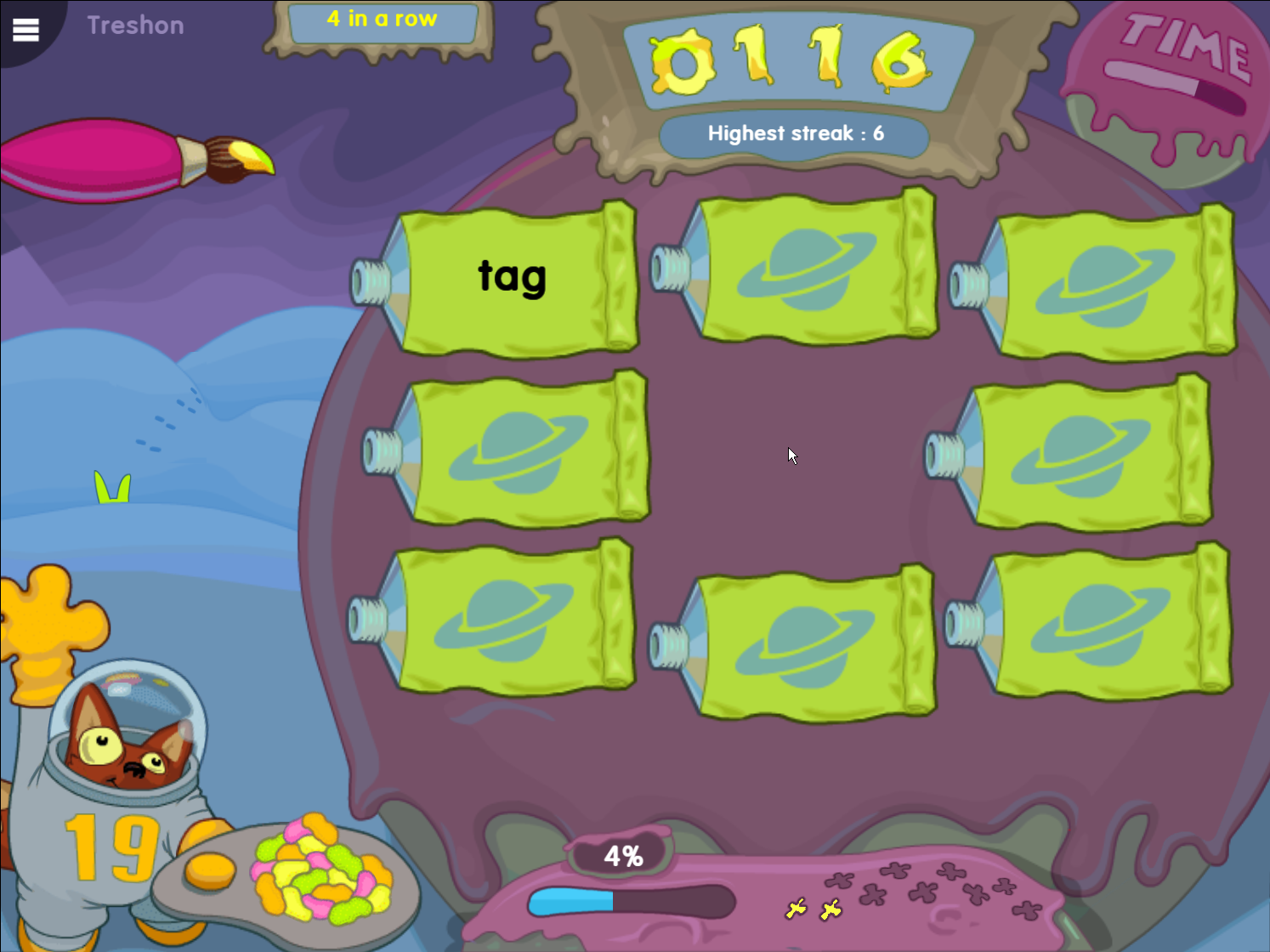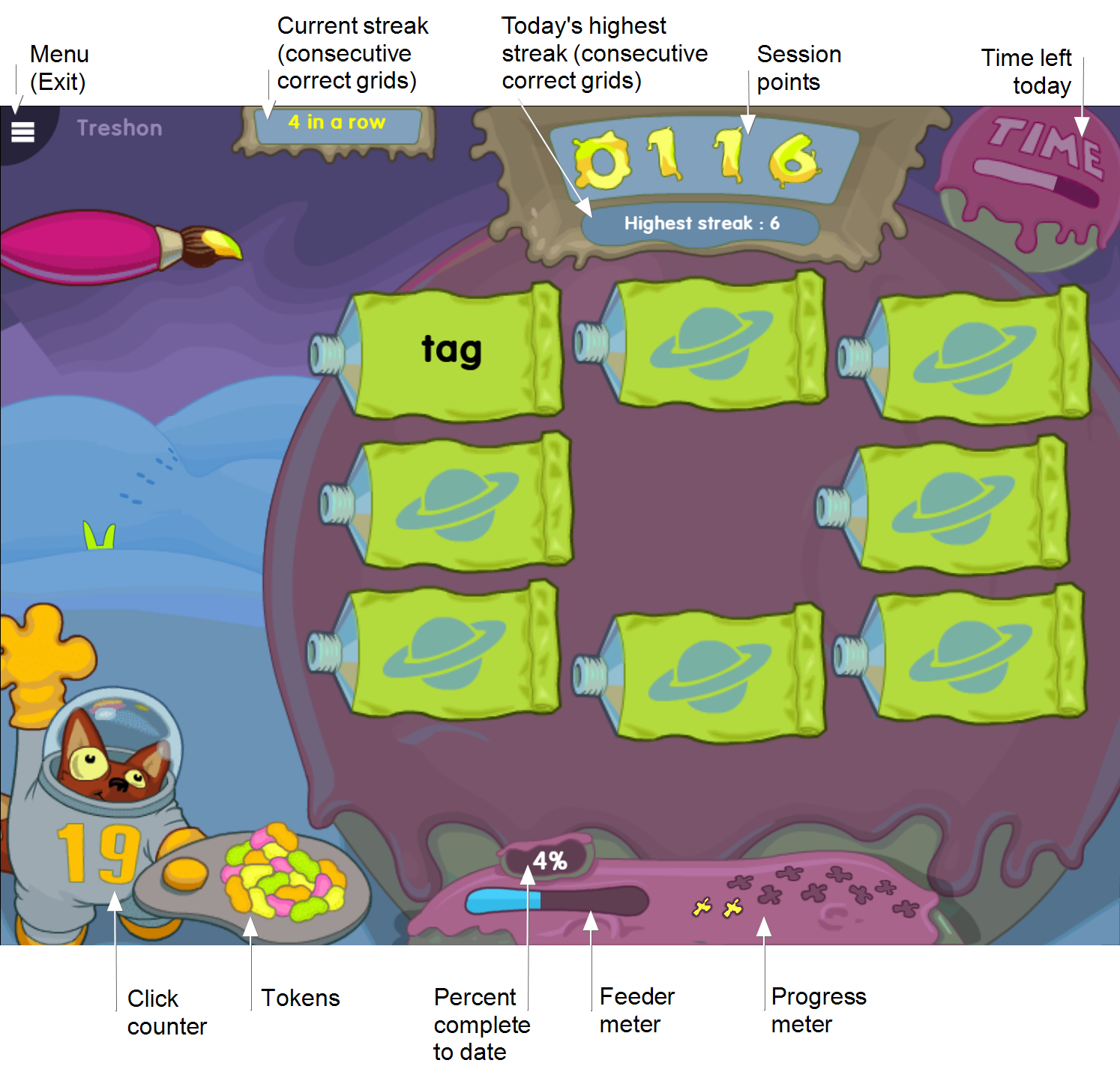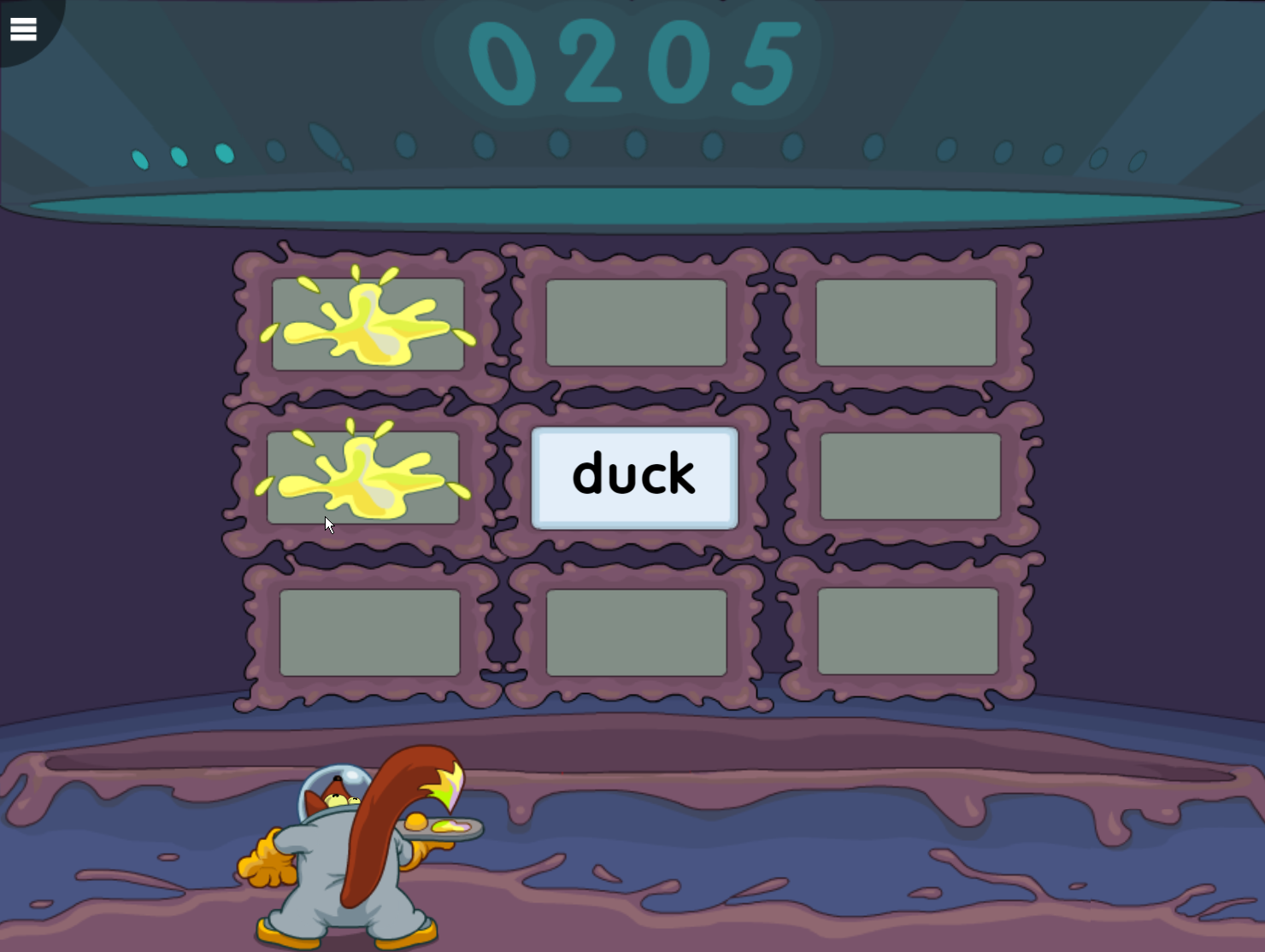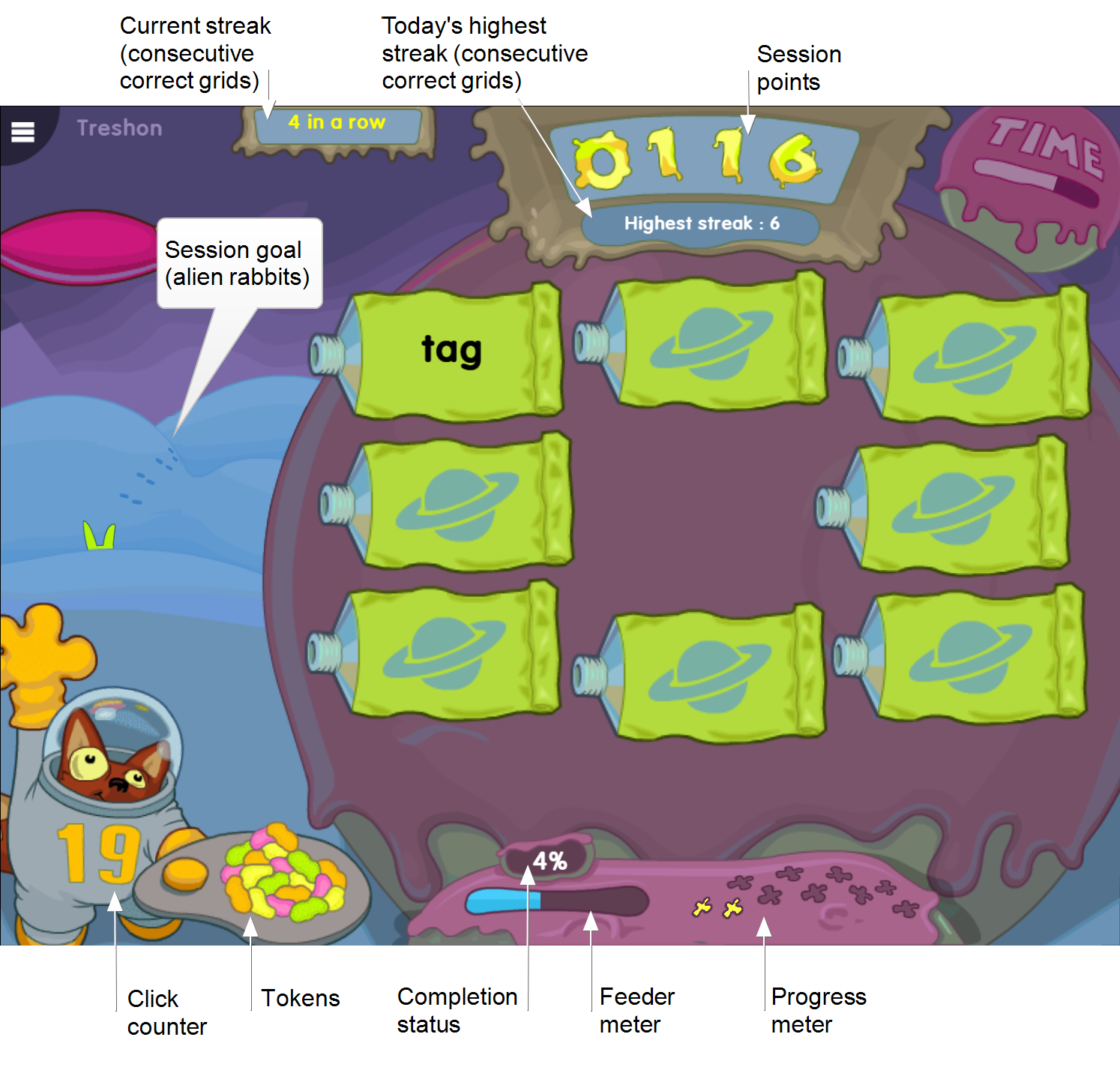Foundations II – Paint Match
On this page:

About Paint Match
The Fast ForWord Foundations II exercise Paint Match focuses on the following tasks, goals, and skills.
Task. Match all the words into pairs using the fewest attempts.
Goal. Develop the following cognitive and language & reading skills:
|
Language & reading skills |
|
|
Word analysis |
The ability to recognize words, the ability to recognize the relationship between letters and sounds, and the ability to understand letter patterns. |
|
Phonological accuracy |
The ability to make correct distinctions based on individual phonemes (e.g., matching words that begin with the same sound) or other aspects of phonology (e.g., rhyming, number of syllables). |
|
Cognitive skills |
|
|
Memory |
The ability to use auditory and visual-spatial working memory to locate matching word pairs in a grid. |
|
Attention |
The ability to focus and sustain attention. |
|
Processing |
The ability to process spoken and written words. |
About the science
Paint Match presents words that differ by a single consonant, consonant cluster, or vowel. For example, the words clock and block differ by initial consonant cluster. As the student progresses through the content, the differences occur at the beginning, ending, or middle of the words. At the highest level, Paint Match also presents “alien” words—nonsense words that use basic English spelling patterns—to encourage accurate decoding for unfamiliar words. For details see the content list.
Paint Match includes Scientific Learning’s patented speech processing technology.
- At first, Paint Match presents words in which the speech sounds have been digitally altered using patented methods (including selective intensity increases) to provide enhanced learning opportunities. Initially, the consonant sounds in each word have been enhanced relative to the vowel sound. For example, the word bit is initially presented with acoustically modified versions of the /b/ and /t/ sounds.
- As the student progresses through the exercise, Paint Match decreases this processing, and eventually presents the words using natural speech.
Note: Foundations I includes all five patented speech processing levels, whereas Foundations II only includes the highest three processing levels (Levels 3-5).
How students use Paint Match
Paint Match displays paint tubes in grids of four, eight, and sixteen. Each paint tube has a word associated with it. The object of Paint Match is to match all the words into pairs in the fewest attempts.
To work on Paint Match, the student clicks a paint tube on the screen. The exercise pronounces a word and displays that word on the tube. The student must click the other paint tubes on the screen to find the paint tube with the matching word. If the student clicks a new paint tube that matches one already clicked, the word is pronounced but not displayed. The student must then go back and click the first paint tube of the pair to confirm the match. The two paint tubes disappear.
In Paint Match, the student starts out matching words. As the student progresses, Paint Match introduces nonsense words. The color of the paint tubes indicates which word type the student is currently working on:
![]() Actual words = green paint tubes
Actual words = green paint tubes
![]() Nonsense words = orange paint tubes
Nonsense words = orange paint tubes

|
Click counter. The number on the fox’s space suit represents the number of attempts available to match all of the paint tubes in the grid. Each time the student clicks a paint tube, this number is reduced by one, and one of the tokens on the paint palette disappears. When the student matches all of the paint tubes on the screen within the allowed number of attempts, the exercise awards the remaining tokens as bonus points. If the counter reaches zero before the student has made all the matches, the grid closes and the student starts over with a new grid. |
|
Time. The timer at the top of the screen shows the amount of time the student needs to work on the exercise that day, which is based on the student's protocol. It fills in from left to right as time elapses. When the time requirement is met, the exercise automatically closes and returns to the remaining exercises scheduled for that day. If this is the last exercise for the day, Today’s report opens. |
|
Menu. The student can use this menu to exit the exercise early, to check the network connection status, and to see exactly how much time is left to meet the day’s protocol for that exercise. To learn more see Exiting an exercise. |
Speed Round
As the student progresses in the exercise, Paint Match presents the Speed Round (or Fluency Round). In the Speed Round, the student identifies target words within groups of similar words.
To work on the Speed Round, the student clicks the Go button to hear a target word pronounced. Words appear on the picture frames in the top row, one at a time, from left to right. When the target word appears on a picture frame, the student must click the target word. The student should respond as quickly as possible, without making mistakes, to earn the most points.
When the student finds all the target words on the Speed Round screen correctly, the student earns tokens, which appear as lights above the picture frames. The paintbrush token indicates the highest token ever earned. If an incorrect word is painted, or a target word is missed, all tokens are lost and the Speed Round starts over. At the end of the Speed Round, any remaining tokens are awarded as bonus points. When the Speed Round ends, the student returns to the main exercise.
Paint Match tracks student responses during the Speed Round, but does not use this information to advance the student’s standing in the exercise. Instead, the Speed Round is an opportunity for the student to review the material at a faster pace and earn extra points.

How students progress in Paint Match
Introduction
Paint Match starts with an interactive demonstration that introduces the exercise. The introduction will not be presented again.
Tip: You can choose to present the introductions, instructions, and any interventions in another language, if needed. See Fast ForWord exercise intro languages.
Progression
In Paint Match, the student progresses through content across three speech processing levels. Each level includes sets of words grouped by different sound changes.
- In Levels 3 and 4 (processed speech), the student progresses through the same three groups.
- In Level 5 (natural speech), the student progresses through all groups, alternating between groups of real words and nonsense words.
|
Group |
Sets/Words |
|---|---|
|
Group 1 Initial/final consonant change |
Set 1. big, bit, dig, dip, kick, kid, kit, pick, pig, pit, tick, tip Set 2. buck, bud, but, cup, cut, duck, dug, pub, pup, tub, tuck, tug Set 3. back, bag, bat, cab, cap, cat, gap, pack, pat, tack, tag, tap |
|
Group 2 Initial consonant or |
Set 4. beat, meat, neat, seat, feat, heat, peat, pleat, cleat, wheat, cheat Set 5. block, dock, hock, jock, lock, mock, sock, tock, rock, clock, shock Set 6. bake, cake, make, sake, fake, take, lake, rake, wake, brake, shake Set 7. pair, fair, hair, chair, stair, dare, care, mare, rare, share, blare Set 8. dear, gear, near, fear, tear, rear, hear, sear, clear, shear, spear |
|
Group 3 Vowel change |
Set 9. big, beg, bug, bag, bet, bit, bat, but, bed, bid, bad, bud Set 10. peg, pig, pug, pog, pot, pat, pet, pit, pup, pop, pip, pep Set 11. luck, lock, lick, lack, puck, peck, pack, pick, tack, tick, tuck, tock |
|
Group 4 Nonsense words Initial/final consonant or |
Set 12. blun, blund, blunk, brun, brund, brunk, plunt, plun, plund, prunt, prunk, prund Set 13. skef, skelf, skelt, stet, stef, stelf, krelt, kret, kref, trelf, trelt, tret Set 14. slond, sloft, slomp, sloff, plomp, ploft, ploff, plond, spond, spoff, spoft, spomp |
|
Group 5 Nonsense words Initial consonant or |
Set 15. blesk, bresk, plesk, presk, dresk, tresk, fresk, stesk, spesk, gresk, cresk, clesk Set 16. bloot, broot, ploot, proot, droot, troot, sloot, stoot, spoot, groot, croot, gloot Set 17. blins, brins, plins, prins, drins, trins, slins, stins, flins, frins, crins, clins |
|
Group 6 Nonsense words Vowel change |
Set 18. drand, drend, drind, drond, drast, drust, drist, drost, dreff, driff, droff, druff Set 19. splag, spleg, splig, splog, splup, splap, splep, splip, splob, splub, spleb, splab Set 20. blach, blech, bluch, blash, blesh, blish, blosh, blath, bleth, blith, bloth, bluth |
Within each set, the student progresses through 6 stages. Each stage includes a specific grid size:
- Stages 1-2 presents 3x3 grids of 8 tiles (4 matches)
- Stages 3-6 presents 4x4 grids of 16 tiles (8 matches)
Advancement
In Paint Match, the student must meet the following criteria to advance in the exercise:
- To advance to the next stage within a set, the student must pass the current stage by making all of the matches within the allowed number of clicks (or touches on a touch-screen device). The student can track remaining attempts on the click counter. If the student runs out of clicks before making all of the matches, the student is demoted one stage.
- 3x3 grids. Up to 20 clicks allowed
- 4x4 grids. Up to 60 clicks allowed
- To advance to the next set within a level, the student must pass the highest stage. Paint Match adapts to the student’s performance within each set, and will transition the student to the next set if the student repeatedly fails in the early stages. The set will be revisited later in the level.
- To advance to the next level, the student must pass all sets in the current level.
Interventions
The exercises use built-in, responsive technology to detect when a student is struggling and administer targeted, inline instruction—right when the student needs it—without any external resources or assistance required. This “smart learning” design helps reduce frustration as it quickly gets students back on track, where they can continue making progress and achieving gains.
Paint Match provides a variety of in-exercise interventions when needed, such as:
- Coaching
- Modeling
- Motivations
The student can receive 1 or 2 of these interventions at a time, depending on the task and difficulty level in which the student is struggling. Each one can take anywhere from a few seconds to 2-3 minutes to complete. When appropriate, the student’s progression in the exercise stops temporarily while working through an intervention, then resumes when the student returns to the regular exercise content.
Tip: You can choose to present the introductions, instructions, and any interventions in another language, if needed. See Fast ForWord exercise intro languages.
Mastery
To complete the exercise, the student must master all of the skills in the exercise and reach a percent complete score of 100%. If the exercise is revisited, the student will continue to repeat the content at the highest levels. To learn more see Completing a component.
How Paint Match rewards progress

|
Session points. The exercise awards points as follows: |
|
Feeder meter. The feeder meter tracks and celebrates every 1% of content completion. At 10% complete, the meter is full, and it “feeds” that percentage into the progress meter and resets. For more on percent complete scores see the student’s Progress report |
|
Progress meter. The progress meter tracks and celebrates every 10% of content completion. Each marker represents 10% of the exercise. When all 10 markers light up, the exercise is complete. For more on percent complete scores see the student’s Progress report. |
|
Completion status. The completion status sign shows the actual percent complete score for the exercise. The score updates each time the student completes 1%. For more on percent complete scores see the student’s Progress report. |
|
Highest streak. At the start of each new day, the exercise tracks and shows the student’s best “winning streak” of consecutive grids passed. The score appears early in the exercise, and remains on the screen throughout the day. Any time the student surpasses his or her highest streak that day, the sign updates to show the latest number. The highest streak score resets to zero at the start of the next day. |
|
More rewards. In addition to the current streak sign, the exercise uses other fun animations to encourage progress.
|